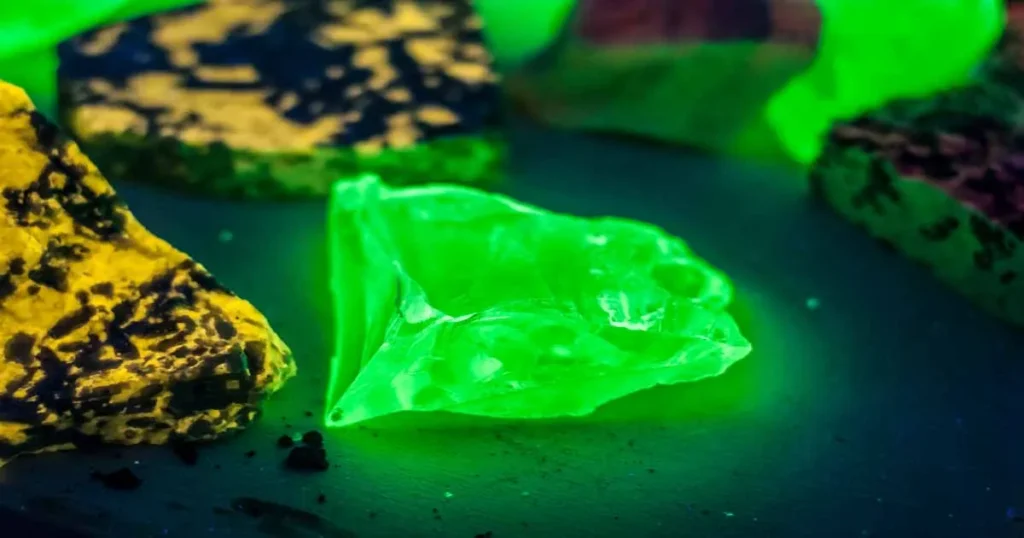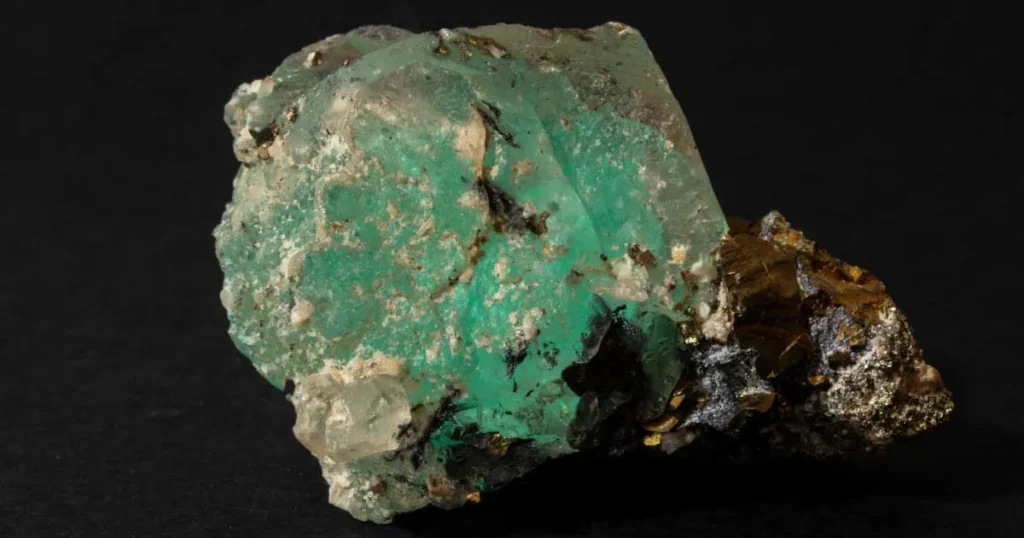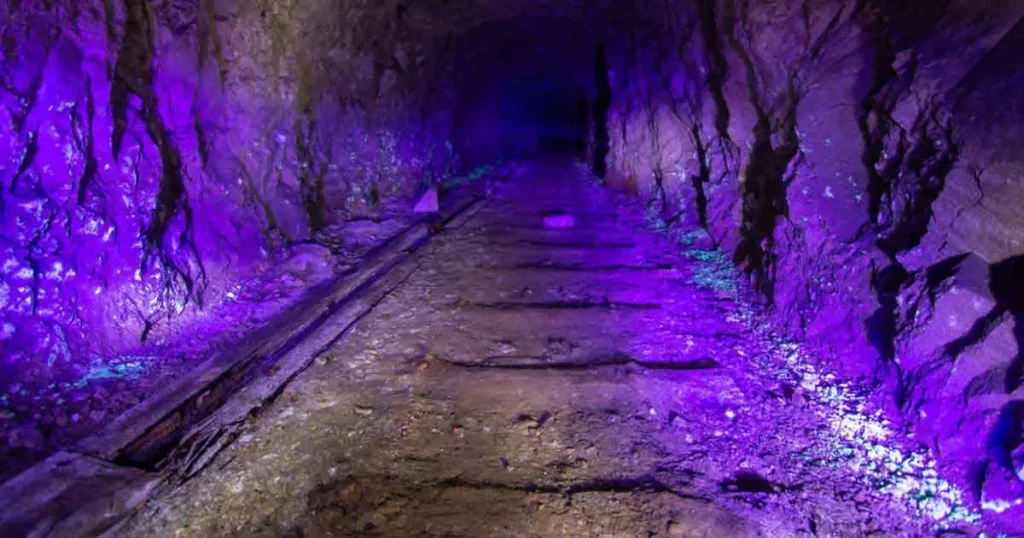When most of us hear the letters “UV”, we think of sunburn, tanning salons or forensic investigations. But ultraviolet light also highlights the beauty of minerals at night. Ultraviolet light is a fascinating aspect of mineral light expression. Minerals also give off a mysterious glow under UV light, and when viewed under a microscope, you can see that the sparkle we see is actually made up of thousands and millions of smaller particles, all put in place by nature.
If you have ever been awed by the beauty of nature, that UV light glow will never be real again. This story comes from a series of articles that appeared in Popular Science Weekly in 1947 on the subject of “Ultraviolet”. The entire issue was deemed suitable, but it was too long for an illustrated feature, so it was put together; Wonders of Ultraviolet Light — A New German Discovery and so on.
UV-A and UV-C light sources are commonly used by mineral hobbyists to study the fluorescence of minerals.
How Does UV Light Interact with Minerals?
UV radiation has an impact on some minerals by exciting electrons in their atomic structure. These electrons jump to higher energy states. When they fall back to their normal position, they release all the energy as visible light. This is the reason rocks like Franklin give off their strange, otherworldly glow when meeting up with UV rays in an otherwise completely dark room – no other mineral does this.
Not all minerals fluoresce, as different types emit different colors when exposed to ultraviolet light, fluorescence depends not only on the composition of the mineral but also on its impurities or “activators”. Common activators are manganese, lead, and uranium. In addition, the specific wavelength of the light used has a major influence on what can be seen.
This is not only a visual experience, but also a chance for you to see the world in unique colors and patterns, all in varying intensities. You’ll wonder how we’ve gone so long without this fantastic opportunity!

Minerals That Fluoresce Under UV Light
Different minerals glow in different colors and intensities demonstrating fluorescence. The examples are extremely popular because of such specific attributes that some minerals acquire under light; the following should be mentioned here:
- Fluorite: Named after its fluorescent properties, fluorite glows in a range of colors, from blue to purple, under UV light.
- Calcite: Due to manganese impurities, it often glows red, pink, or orange.
- Willemite: This is a fluorescent zinc silicate mineral that glows bright green under UV light.
- Scheelite: You can spot this mineral by its strong blue-white glow.
- Opal: Some types glow in a soft orange or green tone.
- Hackmanite: Shows tenebrescence, i.e. a color shift that can be reversed by ultraviolet radiation.
These minerals, created by Mother Nature, are sought after by mineral collectors both for their preserved beauty and for the mysterious luster they develop when exposed to UV light.
Tools for UV Light Mineral Exploration
To check the glow of minerals, you need a reliable UV lamp. Here are some tools commonly used by rock enthusiasts and experts:
- Portable UV lamps: These light and easy-to-carry lamps work great in the field.
- Dual-wavelength lamps: With one instrument, dual-wavelength lamps produce both long-wave (UV-A) and short-wave (UV-C) light, assisting you to do more.
- UV Flashlights: They are inexpensive UV light sources and great for beginners.
- UV Cabinets: These boxes create the right environment for deep dives in the laboratory.
Always be cautious when using UV light. Wear protective glasses and make sure that your skin doesn’t absorb too much of it.

Applications Beyond the Glow
The way UV light interacts with minerals offers numerous real-world applications and is more than just an attractive sight.
1. Mining and Geology
Geologists use ultraviolet light to locate and map mineral deposits. Scheelite fluorescence can be used, for example, to detect tungsten ore deposits.
2. Gemology
For verifying and identifying gemstones, UV fluorescence is a crucial instrument in gemology. For instance, diamonds usually exhibit blue fluorescence, which can help to locate their source, and grade them.
3. Forensics and Art Restoration
UV light is used in forensics to detect counterfeit minerals or altered gemstones. It is also used in art restoration to make hidden mineral pigments and repairs visible.
4. Education and Public Relations
In museums and educational institutions, they are often highly attractive exhibit that arouses interest in the geosciences.
Science Behind the Glow
A closer examination of the atomic structure explains why some minerals fluoresce and others do not. Some impurities or activators can alter the atomic energy levels of the mineral. For example:
- Manganese: Frequently causes calcite to glow red or pink.
- Uranium: Gives minerals like autunite their bright green fluorescence.
- Lead: Assists in providing rocks such as fluorite with their blue fluorescence.
Strangely enough, some minerals also show “phosphorescence”, a light that continues to glow even when the UV light source is switched off. Research on UV minerals is further enhanced by this lingering emission.

Collecting Glowing Minerals
Glowing minerals are a rewarding and pleasing hobby for individuals who wish to start collecting them. These pointers can help you get started:
- Research Locations: There are some locations on the globe that are specific to fluorescent minerals. The fluorescent mineral variety of the Franklin and Sterling Hill mines in New Jersey, USA, is famous.
- Invest in Equipment: To explore and collect, a decent UV lamp and protective equipment are required.
- Learn the Science: You can enjoy each specimen more if you know about its properties and fluorescence processes.
- Join Communities: Internet forums and mineral clubs provide networking and useful information.
Difficulties and Moral Aspects
Although collecting glowing minerals may be exhilarating, it’s necessary to be careful. Irresponsible mining methods may harm local environments, and over-collecting can strip away natural habitats. Prefer sustainable methods, respect property rights, and always follow the law.
Conclusion
The world of ultraviolet light and minerals is testimony to nature’s hidden wonders. From the brilliance of calcite to the phosphorescence of rare specimens, UV light is a surprising educational and entrancing insight into the natural world. Whether you are an advanced geologist, budding collector, or interested bystander, prospecting for fluorescent minerals is a unique combination of science, art, and adventure.
So next time you come across a stone in the road, hold it for a moment and imagine the infinite possibilities that lie within this seemingly dull object. Armed with a UV light, you could discover a treasure that glows in the dark.

